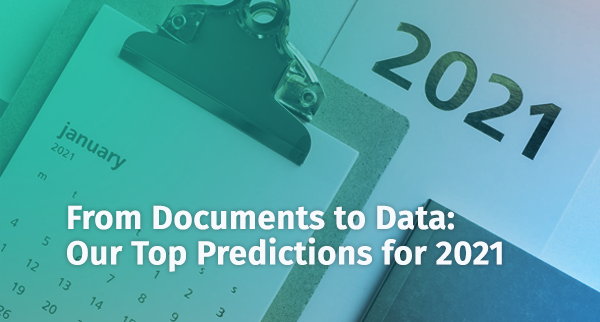
2020 was a wild and crazy year, but for software solutions that transform documents into data, there was one key trend: Acceleration of the digital transformation. Everyone has realized that as we moved to Work From Home, having teams do manual data entry from their living room couches was an unreliable business process. The race to automate is on!
These past months we spoke with many companies looking to remove this operational bottleneck. Despite best efforts, not everyone got their pilot and trial started. So as you look to 2021 and move into automation the transformation of documents to data, here are our top four predictions.
1) The Demise of Big Data, the Rise of Small Data
Five years ago the only way to build an AI system was to assemble a huge set of training data, eg documents marked with field names and data targets. The AI system learned from hundreds of thousands of marked examples and the business implication was that only companies with large big data sets could build and use AI systems.
In 2021 we expect to see more Small Data solutions. GLYNT, which uses ‘Few Shot’ learning, is one of these. When only a handful (2 – 7) documents are needed for training, any department can set up an AI-powered document solution. Few Shot learning is used by Google and others in image classification as well. When only Small Data is needed, every company, every department can use AI.
2) Serving the Citizen User
Every AI system is a dance between human intelligence and artificial intelligence. In 2021 we expect a shift towards using the intelligence held by employees that don’t code but know your business, eg the operations and the challenges of the everyday. It’s expensive to find and train these folks, so let’s use AI to give them a productivity boost. Look for software solutions that are simple to use, highly accurate and easy to scale. Recently we’ve seen the rise of the Citizen Data Scientist, and the Citizen Developer, now let’s broaden access to Citizen User.

3) Transparency and Validation Required
Trust is in short supply these days. And there is a lot of mis-trust of AI. The winning solution provides a clear window into how data enters the AI system, how it is transformed and the format of how it exits. Accuracy must be measured and validated. A transparent view is a must. No more black box AI.
4) 2021 is the Year of AI Advantage
Our first three predictions have shown that AI is ready for prime time and widespread adoption, so now let’s turn to intent. Companies adopting AI have the power to disrupt their industry in three ways: cutting costs in the back office; producing greater revenues in the front office; and innovating new business models. That’s a pretty fearsome competitor! So 2021 is the time to move forward on AI, it is a must. Demand to see and test the AI in every software solution you evaluate. Don’t buy without it.
The pandemic has accelerated digital transformation, including the adoption of AI. But AI is a disruptive technology, shaking up markets and re-positioning direct competitors. So, 2021 promises to be full of changes. Frankly, we’re looking forward to making our 2022 predictions, based on all of the interesting AI implications of 2021!




